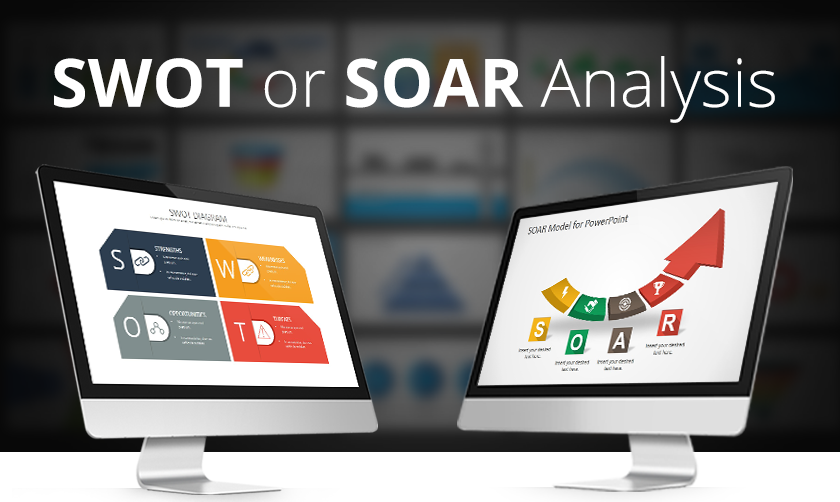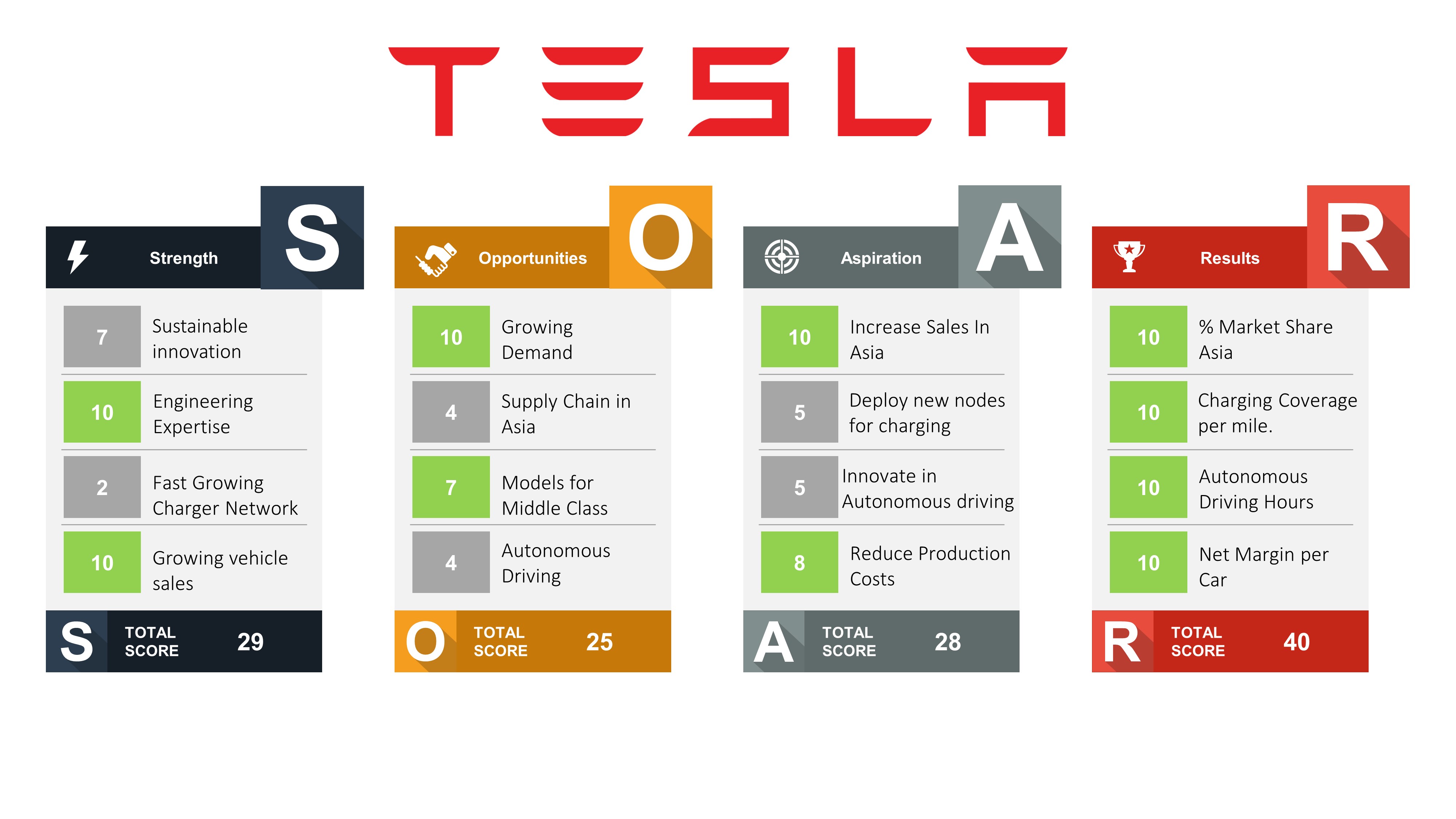Introduction
The SWOT and the SOAR analysis models are two different business management tools that are used as organizational frameworks to enhance business performance. Some organizations use both methods, while other will choose one or the other.
SWOT Analysis is an acronym for Strengths, Weaknesses, Opportunities and Threats. SOAR Analysis, on the other hand, stands for Strengths, Opportunities, Aspirations and Results. Learn a little about each of these business frameworks and how to present them effectively to your audience.
What Is the SWOT Analysis for Businesses
Any organization can benefit from performing a SWOT analysis. This evaluation method helps organizations understand their strengths and weaknesses, as well as identify any opportunities they may have. No strategic planning tool is complete without a threat analysis and a plan for tackling them.
The SWOT analysis is both simple and collaborative, allowing enterprise planning teams to easily generate ideas and strategies. Compared to other strategy planning methods, the SWOT analysis orients strategies around competitive advantage and gap detection. From a human resources perspective, employees can perform their own SWOT analyses in order to help develop their career in a way that makes best use of their talents and abilities.
SWOT Analysis Strategy Outline
The SWOT analysis strategy is a powerful tool that helps organizations uncover opportunities that would have otherwise been missed and leverage their strengths to take advantage of them. On the flipside, organizations can clearly address threats and weaknesses after performing a SWOT analysis.
The advantage of the SWOT analysis is in its focus on both internal and external characteristics. The first two letters in the acronym, strengths and weaknesses, correspond to internal evaluation. The second two letters, opportunities and threats, are usually external factors for the analysis team to investigate.
Here are the basics for each component of the SWOT analysis.
SWOT: Strengths
Those performing a SWOT analysis template for companies should brainstorm what they do better than their competitors. They should also list the technical and non-technical advantages their organization has. Include an analysis of the unique selling proposition your organization has, as well as your value proposition.
This way, you’ll include strengths as seen from an internal view, a client-facing view, and a market comparison.
SWOT: Weaknesses
You’ll want to focus on things that employees see as weaknesses internally, as well as what clients and competitors view as weaknesses of your company. Note that it’s crucial for everyone to be honest and transparent. It’s better to face reality at this stage so you can make the necessary improvements, rather than turn a blind eye and suffer the consequences later.
If you want to make your company SWOT analysis even more helpful, then you’ll analyze possible improvements and solutions for these weaknesses. Don’t forget to look at factors that could be avoided in order circumvent these weaknesses and, in turn, help your organization achieve their objectives.
SWOT: Opportunities
No company wants to miss out on available opportunities. That’s why the SWOT analysis is a useful tool to conduct multiple times, whether yearly or quarterly. This allows you to keep up with the trends in your organization’s field and constantly adjust to the evolving market.
Keep an eye out for both concrete business and marketing opportunities, as well as how changes in government policy and technological advancements present opportunities.
SWOT: Threats
Threats consist of the obstacles and barriers you face while in operation. However, it can also include threats due to changes in your field, technology, policy, or market that can affect or disrupt your organization’s objectives.
Instead of just identifying these threats and moving on, you should also brainstorm what your company can do to react, adjust, improve, and avert these problems.
A Real Life Example – Tesla SWOT
Let’s take a look at a well-known company: Tesla. The first iteration of the SWOT Analysis consists of identifying each of the factors on the SWOT Matrix. The following PowerPoint Presentation outlines the major factors after the first evaluation:
As you can see in the SWOT Analysis PowerPoint Template, nine factors are listed and ready to be presented by the analysis team. Based on these nine points, the analysis team can outline a strategy. The more detail you add to each of these points, the better your resulting strategy can be, of course. The analysis team can continue iterating until they reach more detailed descriptions of each of the four areas of the SWOT analysis.
You can check out the full SWOT Analysis for Tesla in the following video:
SOAR Analysis as a Maturity Step
Where the SWOT analysis focuses on organization strengths and weaknesses, the SOAR analysis engages all levels and functional areas of an organization. The SOAR analysis focuses primarily on strengths, opportunities, and vision for the future. By extending further into future thinking, this analysis technique can be integrated into your strategy planning as a much more rigorous tool than the previous analysis. Keep in mind that this evaluation method will probably take more time than the SWOT analysis.
SOAR Analysis Outline
You’ll see some similarities in the SOAR analysis outline compared to the SWOT analysis, though there are some key differences. For one, this strategy is much more forward-thinking and action-oriented as it focuses on results. Here’s an analysis of each letter of the acronym.
SOAR: Strengths
An organization should focus on its greatest achievements, what makes them unique, and what driving factors guarantee success. This list focuses both on boosting the general morale of staff and making sure that standards are upheld for continued benefit.
SOAR: Opportunities
This pillar focuses on new markets and opportunities, as well as possibilities for improvement. This will also help your company revise how they differentiate themselves and stand out from their competitors.
SOAR: Aspirations
This tool aims to drive the organization towards attaining their goals. Here, you’ll focus on initiatives and processes that will bring you closer to success. You can ask yourselves how your strengths and opportunities will translate into future aspirations for your company.
SOAR: Results
As one of the main benefits of the SOAR analysis, this pillar helps organizations know if they are on the right track towards achieving their goals. Here, you’ll be able to evaluate if you are successfully transforming your vision for your company into a reality.
Recommended: Best SWOT Analysis PowerPoint templates
SWOT Analysis – Real Life Example (continuation)
Previously, we listed the SWOT Analysis for TESLA. In the following example, you can see the SOAR Analysis for the same company. In this case, every characteristic is rated and sorted in order to keep the 4 more important and “related”. This analysis shows how TESLA can take advantage of their company strengths to pursue existing and future opportunities, define the aspirations, and decide which KPI’s will measure them over time. Clearly, the analysis is much richer and more strategically aligned.
Conclusion
Both of these methods are tools that can greatly improve the outlook of an organization. Both SWOT analysis and SOAR analysis help companies deal with external forces and ensure that objectives are well defined. There are pros and cons to choosing one evaluation method over the other. However, if you want to ensure an in-depth analysis, you and your organization may want to perform both methods. There’s no such thing as too much knowledge and understanding when it comes to a company’s success.
Alternatively, discover our articles on how to present a SWOT Analysis and how to develop a Personal SWOT Analysis.






